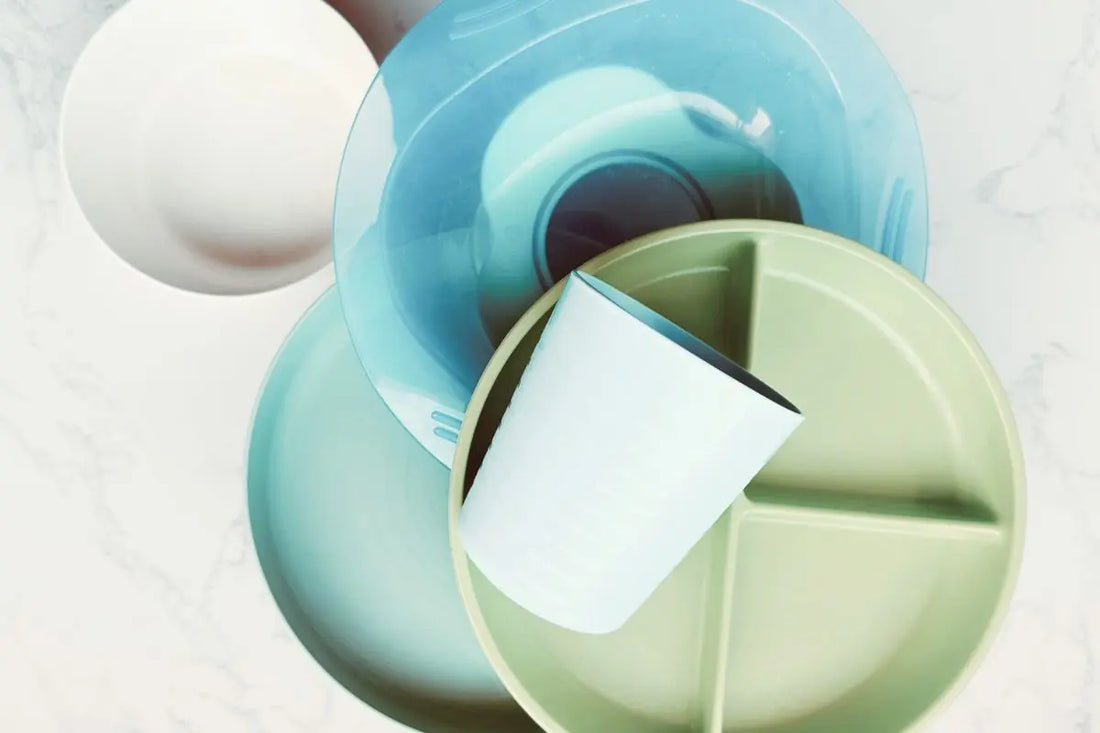Our Plastic Problem: Health Risks, BPA-Free Myths, and Greenvyne's Mission

Our Plastic Problem: Why Greenvyne Exists
When we started Greenvyne, our mission was clear: to create eco-friendly, safe, and practical alternatives for everyday living. But what truly sparked this journey was a realisation that hit close to home. Like many families, we relied heavily on plastics—lunchboxes, food containers, and even the wrapping around fresh produce. At first glance, they seemed harmless, especially with reassuring labels like "BPA-free."
But as I began questioning these choices, I uncovered unsettling truths about plastics, even reusable ones. Keep reading to learn more about what I discovered.
The Truth About BPA: Where It’s Banned and Where It Hides
Let’s talk about BPA—Bisphenol A. This chemical, made by reacting petroleum-derived phenol and acetone with an acid catalyst, is often used to harden plastics and line food packaging. Its petroleum-based origins and widespread use have raised concerns, as it’s been linked to health risks like hormone disruption, fertility issues, and developmental concerns in children. A comprehensive review published in Environmental Health Perspectives highlights BPA's endocrine-disrupting properties and its potential impact on reproductive health and development. Naturally, this has sparked global action.
Several countries have acted on BPA: the EU and Canada banned it in baby bottles, some US states restrict it in children’s products, and Australia worked with manufacturers to voluntarily phase it out of baby bottles and infant products in 2010.
That’s good news, right? Well, not entirely. BPA might be less common in baby bottles today, but it hasn’t disappeared. It’s still used in some cans, tins, and cartons, and it can leach into food, especially when exposed to heat or acidity.
But What About BPA-Free Plastics? Are They Safe?
You’ve probably seen the "BPA-free" labels on reusable plastics and felt a sense of relief—I know I did. And let’s be honest, who hasn’t felt that little thrill of scoring food storage containers on half-price at the supermarket? But here’s the thing: no matter how many we buy, it never feels like enough. That was me—until I learned about the chemicals replacing BPA, like Bisphenol S (BPS) and Bisphenol F (BPF). These substitutes are now everywhere, from water bottles to food storage containers, and here’s the kicker—they’re not necessarily safer.
Research published in Environmental Health Perspectives shows that BPS and BPF can mimic the same hormone-disrupting effects as BPA. So, while we’ve solved one problem, we’ve created another, leaving families like ours searching for better options.
While BPA has been a major focus of plastic-related concerns, it’s just the tip of the iceberg when it comes to the hidden dangers of plastics.
The Truth About Plastics
In addition to BPA, plastics often contain other potentially harmful chemicals like phthalates and lead, which serve specific purposes but come with serious risks.
Plastics aren’t just made of one material—they’re a complex cocktail of chemicals designed to serve specific purposes. Beyond BPA, other harmful substances like phthalates and lead are often present. Phthalates, for instance, are used to make plastics flexible and are found in food storage containers, drink cups, and even toys. Meanwhile, some imported or older products still contain lead, a toxin linked to cognitive impairments and developmental delays in children. Both chemicals have been shown to leach into food and drinks, particularly when plastics are exposed to heat or prolonged use.
Phthalates in Action: Heating or microwaving plastic containers can release these chemicals into food, as confirmed by the National Institutes of Health (NIH). Even low doses have been linked to endocrine disruption, reproductive health issues, and metabolic changes.
What’s Really Lining our Cans and Cartons?
Ever wonder how canned food stays fresh, or why cartons don’t leak? That’s thanks to their linings—often made with plastics or resins. For years, BPA was the go-to material for this. Today, many manufacturers claim to use BPA-free linings, but they often replace it with alternatives like epoxy resins, acrylic coatings, or polyvinyl chloride (PVC).
According to Food Standards Australia New Zealand (FSANZ), some of these materials can still leach chemicals into food, especially when exposed to heat or stored for long periods. It’s not just about avoiding single-use plastics anymore; it’s about understanding the hidden dangers in all plastics.
The Invisible Threat of Microplastics
Let’s shift gears to something we can’t see—microplastics. These are tiny fragments that break off as plastics degrade. They’re found in our water, soil, air, and even food. Scientists have even detected microplastics in human blood and organs. I don’t know about you, but as a parent, that hit me hard.
A study in Science Advances revealed just how pervasive microplastics are, affecting everything from marine life to agriculture. Worse, they’re nearly impossible to get rid of, taking centuries to break down and releasing toxins in the process.
It’s not just about where they end up—it’s about what they do. The World Health Organisation (WHO) has flagged concerns about microplastics causing oxidative stress, inflammation, and hormonal imbalances in humans. These tiny particles might be invisible, but their impact on our health and the planet is anything but.
A World Full of Plastic for Kids
Understanding the risks associated with these chemicals becomes even more crucial when we consider how much plastic children interact with daily.
Our children are surrounded by plastics from the moment they’re born. Many babies are fed using plastic bottles and use plastic pacifiers, often sterilized with high heat. Studies have shown that heating plastic bottles can release microplastics into liquids. Research from Trinity College Dublin found that an infant fed with plastic bottles can ingest millions of microplastic particles daily—significantly more than adults are exposed to.
Children’s developing bodies make them especially vulnerable to these toxins. According to WHO, their metabolic systems may not efficiently eliminate harmful substances, meaning toxins can linger longer in their bodies, potentially affecting their growth and development.
The Human Body and Plastic Toxins
It’s not just about exposure—how our bodies process these toxins also plays a critical role in their long-term impact.
When plastics leach chemicals, our bodies absorb them through food, air, or water, where they enter the bloodstream. While some toxins are expelled quickly, others, like phthalates and bisphenols, can accumulate. Research by the NIH shows that individuals with compromised health conditions, such as metabolic disorders or developmental disabilities (e.g., Down syndrome), may process these toxins less efficiently. This leads to prolonged exposure and increased susceptibility to hormone disruption and immune system challenges.
Even in healthy individuals, long-term exposure to small amounts of these chemicals can cause inflammation and oxidative stress, which may contribute to chronic health conditions. This highlights the critical importance of minimising plastic exposure wherever possible—not just for environmental reasons, but for our health as well.
A Global Plastic Crisis
Here’s a reality check: the world produces over 430 million tonnes of plastic every year, according to the OECD. And only 9% of it gets recycled. The rest ends up in landfills, our oceans, or as litter.
The United Nations’ World Plastic Treaty is working toward solutions, but it’s a massive challenge. The more I learned, the more I realised—real change starts at home, with the choices we make every day.
So, What Can We Do?
When I started making changes at home, I realised just how overwhelming it can feel to rethink the products we use every day—especially with the added cost of making these changes in today’s cost of living. But here’s the thing: it’s also empowering. Even small steps add up over time.
Here are a few ways I’ve found to reduce our family’s reliance on plastic:
Swap Plastics for Safer Alternatives:
Use stainless steel or glass containers without plastic lids. Try beeswax, silicone wraps or food storage bags instead of traditional plastic wraps.
Avoid Heating Food in Plastic:
Never heat food in plastic containers, even if labelled "microwave-safe" to avoid chemical leaching.
Choose Fresh, Unpackaged Foods:
Buy fresh produce without plastic linings. Local fresh food markets offer more variety, better prices, and less waste than supermarkets. When it's cheap, buy in bulk and freeze for off-season.
Avoid New Plastic Products:
Skip plastic toys and opt for wood/silicone toys where possible, avoid buying plastic water bottles, ready-to-drink beverages in plastic-lined cartons, canned foods, and plastic-packaged goods.
Recycle Responsibly:
Recycle reusable plastics and properly dispose of single-use plastics to reduce pollution and microplastic accumulation in landfills and oceans.
Reduce Plastic in Daily Routines:
Bring your own reusable bags, water bottles, and coffee cups to minimise single-use and reusable plastics.
Switch to Sustainable Kitchen Essentials:
Replace plastic sponges, dish brushes, and utensils with durable, eco-friendly alternatives like bamboo or stainless steel.
Store Leftovers Wisely:
Use stainless steel lunchboxes, food storage containers or silicone bags instead of plastic containers.
Support Plastic-Free Products:
Choose items with minimal or no plastic packaging to support sustainable practices—like Greenvyne and many other sustainable Aussie businesses.
Start Small and Stay Consistent-This is important:
Remember, it’s about progress, not perfection. Even replacing a single plastic item in your home can make a meaningful difference in your family's health and the environment over time.
It’s not about being perfect—it’s about being better.
"We don’t need a handful of people doing zero waste perfectly. We need millions of people doing it imperfectly."
– Anne-Marie Bonneau, Zero Waste Chef
Why We Created Greenvyne
If you have read this far, you already know why we exist. Greenvyne isn’t just a business—it’s a reflection of our journey and the lessons we’ve learned. It’s our way of sharing solutions that genuinely make a difference. Every product we create, from stainless steel plates and lunchboxes to sustainable kitchen essentials, is thoughtfully designed with busy families like ours in mind—helping you spend less time worrying and cleaning, and more time enjoying moments with your little ones.
Reducing exposure to harmful plastics isn’t just about cutting back on single-use items—it’s about making thoughtful choices in everyday life. Our products are designed to help families take small but meaningful steps, whether it’s reducing plastic in the kitchen or creating healthier habits for your kids. Together, we can build a safer, more sustainable future—not just for ourselves but for generations to come.
When we think about the world we’re leaving for our kids, we know we have to do better. The changes we’ve made in our own home inspire us to help others take steps toward a healthier, more sustainable life. Explore the products we’ve poured our hearts into and discover how they can help your family live safer, healthier lives while showing kindness to all living things on our planet.
Disclaimer
The information provided in this blog is based on my personal research and understanding, drawn from articles and studies published by various industry bodies, government agencies, and credible organisations. While I have cited sources where appropriate, this blog is intended for informational purposes only and should not be considered professional or authoritative advice. Readers are encouraged to consult primary sources or qualified professionals for specific concerns or further clarification.








